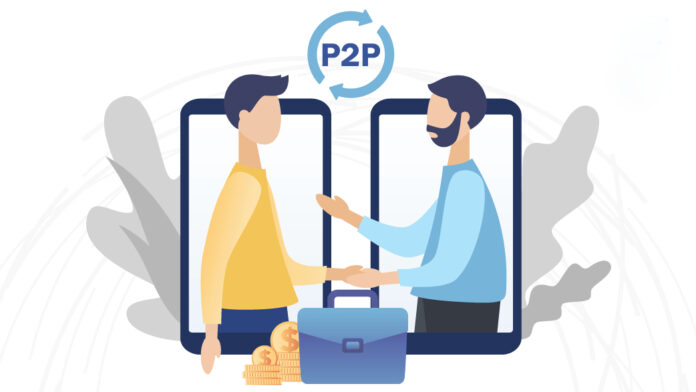
Peer-to-peer (P2P) lending has revolutionized the world of finance, allowing individuals to lend or borrow money directly from one another, bypassing traditional banks. This form of financial technology has gained immense popularity due to its ease of access, streamlined processes, and potential for higher investor returns.
In this article, we will delve into the fundamentals of P2P lending, explore some of the best platforms available, and understand how it works.
Understanding Peer-to-Peer (P2P) Lending

Peer-to-peer lending has transformed the lending landscape, allowing borrowers and investors to connect directly through online platforms. This section explores the basics of P2P lending and why it has become an attractive alternative to traditional banking.
What Is Peer-to-Peer (P2P) Lending?
Peer-to-peer lending, also known as P2P lending or social lending, enables individuals to lend and borrow money without intermediaries like banks. P2P lending websites act as facilitators, connecting borrowers seeking funds with investors looking to earn attractive returns on their savings. The key points to consider include:
- P2P lenders are individual investors aiming for higher returns than conventional savings accounts.
- P2P borrowers seek alternatives to traditional banks or lower interest rates for their loans.
- Default rates for P2P loans are generally higher than those observed in traditional finance, making risk assessment crucial.
Best Peer-to-Peer Lending Platforms
Several P2P lending platforms with unique features are available in the market. Here, we explore three of the best platforms based on specific criteria:
LendingClub: Best for Debt Consolidation
LendingClub is an excellent choice for consolidating multiple debts into one manageable loan. Key features include:
- Direct payment to creditors, simplifying debt consolidation.
- Loan amounts range from $1,000 to $40,000.
- Origination fees between 2% to 6% reduce the final loan amount received.
- No prepayment penalties, enabling early loan repayment.
- Co-applicants accepted, potentially securing a lower interest rate.
Prosper Personal Loans: Best for Quick Funding
Prosper Personal Loans stands out for its quick funding options, making it ideal for urgent financial needs. The platform offers:
- Joint applications for co-borrowers.
- Loan amounts between $2,000 and $50,000 with the possibility of next-day funding.
- APR for Prosper personal loans ranges from 7.95% to 35.99%.
- Origination fees between 2.41% to 5% are deducted from the loan proceeds.
Upstart Personal Loans: Best for People without Credit History
Upstart Personal Loans caters to borrowers with limited credit history or lower credit scores. Key highlights include:
- Loan amounts up to $50,000 with a minimum credit score requirement of 600.
- Acceptance of applicants with no credit history, providing options for those with lower credit scores.
- Co-applicants accepted to secure a lower interest rate potentially.
- Charges origination fees (up to 12% of the borrowed amount) and late fees.
The Mechanics of Peer-to-Peer (P2P) Lending

Understanding how P2P lending works is essential for both borrowers and investors. This section takes a closer look at the mechanics of P2P lending, its process, and some considerations.
How Does Peer-to-Peer Lending Work?
P2P lending involves several steps that connect borrowers directly to lenders, facilitating a smooth transaction. Key elements of the process are:
- P2P lending websites connect borrowers to lenders and set rates and terms.
- Investors opening accounts and depositing funds for lending.
- Loan applicants undergo a risk assessment based on their financial profile.
- Borrowers review and accept offers, with all financial transactions managed through the platform.
Specialized P2P Lending Platforms
Some P2P lending platforms specialize in catering to specific types of borrowers. Understanding these specialized platforms can help users find the best fit for their needs:
- Platforms focusing on small business loans: These cater to entrepreneurs seeking funding for their ventures, offering customized loan options.
- Platforms targeting student loans: These platforms address the financial needs of students and their parents, providing competitive interest rates and flexible repayment plans.
- Platforms for medical financing: Specialized P2P lending platforms cater to medical expenses, including elective procedures or medical emergencies.
Lending Money to a Friend in the UK
While P2P lending is an option, guaranteeing loans for friends in the UK through formal guarantor loans can offer more security and structure. Consider the following aspects:
- Guarantor loans involve traditional lenders and formal agreements.
- You become the guarantor, assuming responsibility for missed payments if the friend defaults.
- Ensure clear communication and understanding of terms and consequences before entering the agreement.
Alternative investment options

Alternative investment options to peer-to-peer lending have gained popularity in recent years as people look for ways to diversify their portfolios and potentially earn higher returns. While peer-to-peer lending platforms offer investors the opportunity to lend money directly to individuals or small businesses, there are other investment avenues worth exploring.
One alternative investment option is real estate crowdfunding. This involves investing in real estate projects or properties through an online platform. Investors can pool their money with others and invest in a range of real estate opportunities, such as residential or commercial properties, without the need for a significant capital allocation. Additionally, real estate crowdfunding platforms provide investors with access to a broader range of investment opportunities, including both debt and equity-based investments.
Another popular alternative investment is investing in venture capital or private equity funds. These funds pool money from various investors to invest in early-stage startups or established private companies. This investment option allows individuals to participate in the growth potential of promising businesses that may not be available through traditional investment channels. However, it is essential to note that investing in venture capital and private equity carries higher risk compared to other investment options.
Furthermore, online trading apps (like Immediate Edge) have gained significant traction in recent years, enabling individuals to trade various financial instruments such as stocks, bonds, commodities, and currencies. These apps provide investors with a user-friendly interface to buy and sell securities and access real-time market data. Online trading platforms offer a wide range of investment options and generally come with lower fees compared to traditional brokerage services. However, it is essential to note that online trading requires knowledge and understanding of the market, and investors should carefully consider their risk tolerance and investment goals before entering this space.
Conclusion
Peer-to-peer lending has democratized finance, providing borrowers access to loans and investors with an alternative investment avenue. The ease of connecting borrowers to lenders and streamlined processes have led to the popularity of P2P lending platforms.
However, investors must be aware of the risks associated with higher default rates compared to traditional finance. Additionally, exploring alternative investments, such as oil trading, offers traders unique opportunities to diversify their portfolios and capitalize on oil price fluctuations.
As with any investment, careful research and due diligence are crucial to make informed decisions and maximize returns while managing risk effectively.











